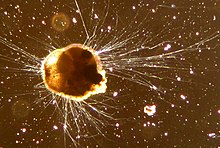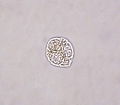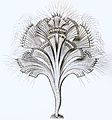| Revision as of 00:18, 22 December 2021 editDjpmapleferryman (talk | contribs)309 editsNo edit summary← Previous edit |
Revision as of 00:37, 22 December 2021 edit undoDjpmapleferryman (talk | contribs)309 editsNo edit summaryNext edit → |
| Line 15: |
Line 15: |
|
}} |
|
}} |
|
|
|
|
|
The '''Rhizaria''' are a species-rich supergroup of mostly ]<ref>{{cite web | url = http://www.palaeos.com/Eukarya/Units/Rhizaria/Rhizaria.html | year = 2004 | author = Christopher Taylor | title = Rhizaria | url-status = dead | archive-url = https://web.archive.org/web/20090420034036/http://www.palaeos.com/Eukarya/Units/Rhizaria/Rhizaria.html | archive-date = 2009-04-20 }}</ref> ]s.<ref name="pmid15148395">{{cite journal |vauthors=Nikolaev SI, Berney C, Fahrni JF, etal |title=The twilight of Heliozoa and rise of Rhizaria, an emerging supergroup of amoeboid eukaryotes |journal=Proc. Natl. Acad. Sci. U.S.A. |volume=101 |issue=21 |pages=8066–71 |date=May 2004 |pmid=15148395 |pmc=419558 |doi=10.1073/pnas.0308602101 |doi-access=free }}</ref> Except for the ] and three species in the genus ] in the phylum ], they are all non-photosynthethic, but many foraminifera and radiolaria have a symbiotic relationship with unicellular algae.<ref>{{Cite journal|last1=Gast|first1=Rebecca J.|last2=Caron|first2=David A.|date=2001-10-01|title=Photosymbiotic associations in planktonic foraminifera and radiolaria|journal=Hydrobiologia|language=en|volume=461|issue=1|pages=1–7|doi=10.1023/A:1012710909023|s2cid=1387879|issn=1573-5117}}</ref> A multicellular form, ''Guttulinopsis vulgaris'', a cellular ], has also been described.<ref>{{cite journal | year = 2012 | author = Brown| title = Aggregative Multicellularity Evolved Independently in the Eukaryotic Supergroup Rhizaria |display-authors=etal | doi=10.1016/j.cub.2012.04.021 | volume=22 | issue = 12 | journal=Current Biology | pages=1123–1127 | pmid=22608512| doi-access=free }}</ref> |
|
The '''Rhizaria''' are an ill-defined but species-rich supergroup of mostly ]<ref>{{cite web | url = http://www.palaeos.com/Eukarya/Units/Rhizaria/Rhizaria.html | year = 2004 | author = Christopher Taylor | title = Rhizaria | url-status = dead | archive-url = https://web.archive.org/web/20090420034036/http://www.palaeos.com/Eukarya/Units/Rhizaria/Rhizaria.html | archive-date = 2009-04-20 }}</ref> ]s.<ref name="pmid15148395">{{cite journal |vauthors=Nikolaev SI, Berney C, Fahrni JF, etal |title=The twilight of Heliozoa and rise of Rhizaria, an emerging supergroup of amoeboid eukaryotes |journal=Proc. Natl. Acad. Sci. U.S.A. |volume=101 |issue=21 |pages=8066–71 |date=May 2004 |pmid=15148395 |pmc=419558 |doi=10.1073/pnas.0308602101 |doi-access=free }}</ref> Except for the ] and three species in the genus ] in the phylum ], they are all non-photosynthethic, but many foraminifera and radiolaria have a symbiotic relationship with unicellular algae.<ref>{{Cite journal|last1=Gast|first1=Rebecca J.|last2=Caron|first2=David A.|date=2001-10-01|title=Photosymbiotic associations in planktonic foraminifera and radiolaria|journal=Hydrobiologia|language=en|volume=461|issue=1|pages=1–7|doi=10.1023/A:1012710909023|s2cid=1387879|issn=1573-5117}}</ref> A multicellular form, ''Guttulinopsis vulgaris'', a cellular ], has also been described.<ref>{{cite journal | year = 2012 | author = Brown| title = Aggregative Multicellularity Evolved Independently in the Eukaryotic Supergroup Rhizaria |display-authors=etal | doi=10.1016/j.cub.2012.04.021 | volume=22 | issue = 12 | journal=Current Biology | pages=1123–1127 | pmid=22608512| doi-access=free }}</ref> |
|
This supergroup was proposed by ] in 2002, although the term "Rhizaria" had been long used for many clades within the currently recognized taxon. Being described mainly from ] sequences, they vary considerably in form, having no clear morphological distinctive characters (]), but for the most part they are ]s with filose, reticulose, or microtubule-supported ]s. In the absence of an apomorphy, the group is ill-defined, and its composition has been very fluid. Many Rhizaria posess mineral exoskeleton (thecae or loricas), which is in different clades within Rhizaria made out of opal ({{chem2|SiO2}}), celestite ({{chem2|SrSO4}}), or calcite ({{chem2|CaCO3}}). It can attain sizes of more than a centimeter with some species being able to form cylindrical colonies approximately 1 cm in diameter and greater than 1 m in length. They feed by capturing and engulfing prey with the extensions of their pseudopodia; forms that are symbiotic with unicellular algae contribute significantly to the total primary production of the ocean.<ref>Caron, D. (2016). The rise of Rhizaria. Nature (London), 532(7600), 444–445. https://doi.org/10.1038/nature17892</ref> |
|
This group was used by ] in 2002, although the term "Rhizaria" had been long used for clades within the currently recognized taxon. Being described mainly from ] sequences, they vary considerably in form, having no clear morphological distinctive characters (]), but for the most part they are ]s with filose, reticulose, or microtubule-supported ]s. In the absence of an apomorphy, the group is ill-defined, and its composition has been very fluid. Some Rhizaria posess mineral exoskeleton (thecae or loricas), which is in different clades within Rhizaria made out of opal ({{chem2|SiO2}}), celestite ({{chem2|SrSO4}}), or calcite ({{chem2|CaCO3}}). It can attain sizes of more than a centimeter with some species being able to form cylindrical colonies approximately 1 cm in diameter and greater than 1 m in length. They feed by capturing and engulfing prey with the extensions of their pseudopodia; forms that are symbiotic with unicellular algae contribute significantly to the total primary production of the ocean.<ref>Caron, D. (2016). The rise of Rhizaria. Nature (London), 532(7600), 444–445. https://doi.org/10.1038/nature17892</ref> |
|
|
|
|
|
==Groups== |
|
==Groups== |
| Line 44: |
Line 44: |
|
==Evolutionary relationships== |
|
==Evolutionary relationships== |
|
{{See also|Eukaryote#Phylogeny}} |
|
{{See also|Eukaryote#Phylogeny}} |
|
Rhizaria are part of the ] (Stramenopiles, Alveolates, Rhizaria), which is turn belongs to a upper-level taxon ] (bikont) ] along with ], ], ], and several minor clades. |
|
Rhizaria are part of the ] (Stramenopiles, Alveolates, Rhizaria), a grouping that had been presaged in 1993 through a study of mitochondrial morphologies <ref>Seravin LN. Osnovnye tipy i formy tonkogo stroeniia krist mitokhondriĭ: stepen' ikh évoliutsionnoĭ stabil'nosti (sposobnost' k morfologicheskim transformatsiiam) . Tsitologiia. 1993;35(4):3-34. Russian. PMID: 8328023.</ref>. SAR is currently placed in the ] along with ], ], ], and several minor clades. |
|
|
|
|
|
Historically, many rhizarians were considered ]s because of their motility and ]. However, when a simple animal-plant dichotomy was superseded by a recognition of additional kingdoms, taxonomists generally placed Rhizarians in the kingdom ]. When scientists began examining the evolutionary relationships among eukaryotes using molecular data, it became clear that the kingdom ] was ]. Rhizaria appear to share a common ancestor with ] and ] forming part of the SAR (Stramenopiles+Alveolates+Rhizaria) super assemblage.<ref>{{cite journal | title = Phylogenomics Reshuffles the Eukaryotic Supergroups| journal = ]| year = 2007 | volume = 2 | pages = e790– | issue = 8| doi = 10.1371/journal.pone.0000790 | pmid = 17726520 | last1 = Burki | first1 = F| last2 = Shalchian-Tabrizi | first2 = K | last3 = Minge | first3 = M | last4 = Skjaeveland | first4 = A | last5 = Nikolaev | first5 = SI | last6 = Jakobsen | first6 = KS | last7 = Pawlowski | first7 = J | pmc = 1949142 | editor1-last = Butler | editor1-first = Geraldine |
|
Historically, many rhizarians were considered ]s because of their motility and ]. However, when a simple animal-plant dichotomy was superseded by a recognition of additional kingdoms, taxonomists generally placed amoebae in the kingdom ]. When scientists began examining the evolutionary relationships among eukaryotes in the 1970's, it became clear that the kingdom ] was ]. Rhizaria appear to share a common ancestor with ] and ] forming part of the SAR (Stramenopiles+Alveolates+Rhizaria) super assemblage.<ref>{{cite journal | title = Phylogenomics Reshuffles the Eukaryotic Supergroups| journal = ]| year = 2007 | volume = 2 | pages = e790– | issue = 8| doi = 10.1371/journal.pone.0000790 | pmid = 17726520 | last1 = Burki | first1 = F| last2 = Shalchian-Tabrizi | first2 = K | last3 = Minge | first3 = M | last4 = Skjaeveland | first4 = A | last5 = Nikolaev | first5 = SI | last6 = Jakobsen | first6 = KS | last7 = Pawlowski | first7 = J | pmc = 1949142 | editor1-last = Butler | editor1-first = Geraldine |
|
| bibcode = 2007PLoSO...2..790B| doi-access = free}}</ref> Rhizaria has been supported by molecular phylogenetic studies as a monophyletic group.<ref name=Burki2008>{{cite journal|last1=Burki |first1=Fabien |last2=Shalchian-Tabrizi |first2=Kamran |last3=Pawlowski |first3=Jan |title=Phylogenomics reveals a new 'megagroup' including most photosynthetic eukaryotes |journal=Biology Letters |date=August 23, 2008 |doi=10.1098/rsbl.2008.0224 |pmid=18522922 |volume=4 |issue=4 |pmc=2610160 |pages=366–9}}</ref> Biosynthesis of ] precursors in various rhizaria<ref>{{Cite journal|last1=Hallmann|first1=Christian|last2=Stuhr|first2=Marleen|last3=Kucera|first3=Michal|last4=Zonneveld|first4=Karin|last5=Bobrovskiy|first5=Ilya|last6=Bowser|first6=Samuel S.|last7=Pawlowski|first7=Jan|last8=Deckker|first8=Patrick De|last9=Nowack|first9=Eva C. M.|date=2019-03-04|title=Putative sponge biomarkers in unicellular Rhizaria question an early rise of animals|journal=Nature Ecology & Evolution|volume=3|issue=4|language=en|pages=577–581|doi=10.1038/s41559-019-0806-5|pmid=30833757|s2cid=71148672|issn=2397-334X}}</ref> suggests a relevant ecological role already during the ]. |
|
| bibcode = 2007PLoSO...2..790B| doi-access = free}}</ref> Rhizaria has been supported by molecular phylogenetic studies as a monophyletic group.<ref name=Burki2008>{{cite journal|last1=Burki |first1=Fabien |last2=Shalchian-Tabrizi |first2=Kamran |last3=Pawlowski |first3=Jan |title=Phylogenomics reveals a new 'megagroup' including most photosynthetic eukaryotes |journal=Biology Letters |date=August 23, 2008 |doi=10.1098/rsbl.2008.0224 |pmid=18522922 |volume=4 |issue=4 |pmc=2610160 |pages=366–9}}</ref> Biosynthesis of ] precursors in various rhizaria<ref>{{Cite journal|last1=Hallmann|first1=Christian|last2=Stuhr|first2=Marleen|last3=Kucera|first3=Michal|last4=Zonneveld|first4=Karin|last5=Bobrovskiy|first5=Ilya|last6=Bowser|first6=Samuel S.|last7=Pawlowski|first7=Jan|last8=Deckker|first8=Patrick De|last9=Nowack|first9=Eva C. M.|date=2019-03-04|title=Putative sponge biomarkers in unicellular Rhizaria question an early rise of animals|journal=Nature Ecology & Evolution|volume=3|issue=4|language=en|pages=577–581|doi=10.1038/s41559-019-0806-5|pmid=30833757|s2cid=71148672|issn=2397-334X}}</ref> suggests a relevant ecological role already during the ]. |
|
|
|
|
A few other groups may be included in the Cercozoa, but some trees appear closer to the Foraminifera. These are the Phytomyxea and Ascetosporea, parasites of plants and animals, respectively, and the peculiar amoeba Gromia. The different groups of Rhizaria are considered close relatives based mainly on genetic similarities, and have been regarded as an extension of the Cercozoa. The name Rhizaria for the expanded group was introduced by Cavalier-Smith in 2002, who also included the centrohelids and Apusozoa.
In 2019, the Cercozoa were recognized as a basal Rhizaria group, as sister of the Retaria.

 Cercomonas sp. (Cercozoa: Cercomonadida
Cercomonas sp. (Cercozoa: Cercomonadida
 Ebria sp. (Cercozoa: Ebridea)
Ebria sp. (Cercozoa: Ebridea)
 Rhipidodendron sp. (Cercozoa: Spongomonadea)
Rhipidodendron sp. (Cercozoa: Spongomonadea)
 Euglypha sp. (Cercozoa: Euglyphida)
Euglypha sp. (Cercozoa: Euglyphida)
 Phaeodarians (Cercozoa: Phaeodarea)
Phaeodarians (Cercozoa: Phaeodarea)
 Clathrulina elegans (Cercozoa: Granofilosea: Desmothoracida)
Clathrulina elegans (Cercozoa: Granofilosea: Desmothoracida)
 Chlorarachnion sp. (Cercozoa: (Chlorarachniophyta)
Chlorarachnion sp. (Cercozoa: (Chlorarachniophyta)
 Vampyrella sp. (Cercozoa: Vampyrellidae)
Vampyrella sp. (Cercozoa: Vampyrellidae)
 Gromia (Cercozoa: Gromiidea)
Gromia (Cercozoa: Gromiidea)
 Powdery scab (Cercozoa: Plasmodiophorida)
Powdery scab (Cercozoa: Plasmodiophorida)
 Foraminiferans (Retaria: Foraminifera)
Foraminiferans (Retaria: Foraminifera)
 Polycystines (Retaria: Radiolaria)
Polycystines (Retaria: Radiolaria)
 Acantharians (Retaria: Radiolaria)
Acantharians (Retaria: Radiolaria)